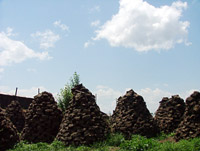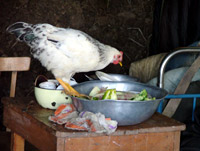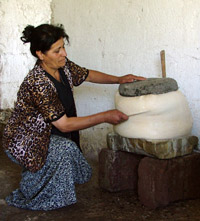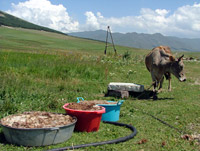
October 15, 2007 | Hasmik Hovhannisyan
Approximately 40 million Kurds live in the world; about 20 million live in Turkey, 9 million in Iran, 6 million in Iraq, 3 million in Syria. And the rest are scattered all over the world. Almost any European country has a Kurdish Diaspora; the largest community is 1 million people and is registered in Germany.

Kurds are the largest ethnic minority in Armenia. Over 80000 Kurds lived in Armenia in the Soviet times, now they make a number of about 40000. In Armenia the Kurdish people are represented by two ethnic groups: the Kurds and the Yezidis. Up to the end of the 1980s the Yezidis were identified with the Kurds. The Yezidis came to be considered a separate minority group when late in the 1980s the Yezidi movement started in Armenia in order to attain the official acknowledgement of their separate identity. There is no point in dwelling on the rather deep and intricate reasons of this phenomenon. Many people in Armenia still think that the Kurds and the Yezidis are two different peoples. Very few know that the Yezidis are the Kurds who have preserved their own religion - Yezidism.
In Armenia only Muslim Kurds are officially considered to be Kurds. There are no more than a thousand of them in the country. The Kurds who practice Yezidism or consider themselves Yezidis by nationality and who are about 40 000 are called Yezidis.
One of the regions with the densest Kurdish-Yezidi population, those who consider themselves Kurds by nationality, but Yezidis by religion - is the Marz of Aragatsotn. 11 out of the 20 villages here are Kurdish. The central village is Alagyaz.

The 75-year-old Bimbash is counting his Amber beads: his face is covered with a net of wrinkles. His unusually light-blue, almost white, eyes are looking into their own depths, into the past. He is singing the sad song of unreturned love. His voice, still youthfully pure and clear, echoes slightly in the room not piled up with furniture. The old man is sitting on a low stool near the furnace; chickens are swarming around his feet.
Bimbash Kochoyan has sung at weddings, christenings, and funerals all his life. He could have become famous. He was offered to have his singing recorded, but he refused - he has enough listeners at home - Bimbash has raised ten children. He fails to remember both the names of his grandchildren and great-grandchildren and their number. Now Bimbash is being listened to by his son Khdr and a couple of neighbors with their children - all of them men. Khdr’s wife is at home, too, but she is not to be seen anywhere. The Kurdish woman is invisible. She does not sit at table with men; neither does she interfere into their conversation.
The men have earth floor under their feet; they have naked walls behind their backs. Mount Aragats can be noticed through the window. Transparent clouds have gathered over the mountain. It seems that steam is coming out of the crater from among the four peaks. It is July, but it is as cold as late in autumn. And the colors are bright autumn tints.



Bimbash moved over to Alagyaz from the region center of Aparan 15 years ago. He says that even though most of the residents of the village are the off-springs of the refugees during the Armenian massacres of Kurd-Yezidis, his ancestors came here much earlier, in the 19th century (the first Kurd truly appeared in Armenia in the mid 19th century.) If in Aparan the Kurds were a minority in comparison with Armenians, in Alagyaz there are only three Armenian families out of one hundred present. However, both here and in Aparan Armenians and Kurds do not lay differences between themselves.
“When in other regions, for example, in the Ararat valley conflicts of everyday life arise between Armenians and the Kurds (Yezidis),” Ghahraman Aloyan, the History teacher at the Alagyaz school says, “The Kurd (Yezid) is to blame. This is not actually a manifestation of racism; rather this is because Armenians stay aloof towards the representatives of ethnic minorities. But we do not have such things here, we are all equal.”
Both Bimbash and the other residents of the village emphasize the fact that they have always lived well in Armenia, unlike anywhere else. Both nations have similar cultures, ways of life, and fates. Both Kurds and Armenians consider the dhol, the zurna, and the saz their national musical instruments. Both peoples have common holidays and traditions.
“Until the 1980’s Armenia was the cultural center for a 40-million nation that had no motherland,” Ghahraman Aloyan says.
The President of the Council of the Kurdish Community in Armenia Count Hasanov says that the reasons for these have been the enjoyed freedom regarding practicing one’s culture, language and traditions, the freedom that the Kurds have enjoyed in Armenia. In Muslim countries where most of the Kurds have lived the Kurdish language, culture, and religion were forbidden. But in Armenia the first newspaper in the Kurdish dialect Kurmanji - The Ria Taza (The New Way) was published in 1930. On the Armenian Public Radio there was an hour and a half long Kurdish program (now half an hour is allocated to the Kurds, and half an hour to the Yezidis). “The Kurdish radio and the Kurdish newspaper in Armenia significantly contributed to the rise of national self-consciousness among the Kurds, especially in Iraq and in Turkey.”
In the Soviet times there was a Kurdish Studies chair at the Oriental Studies Department. The first documentaries devoted to the life of Kurds were made in Armenia, too. In the 1920’s the first Kurdish schools were opened. In the Aragats village of Shamiram a copy of Lalesh, a holy temple complex of the Kurds, situated in the territory of Iran was built.
And the cultural center of the Kurds living in Armenia has always been Alagyaz, which gave the country more than 20 scientists, artists and even two academicians in the course of 70 years.
There was a national theatre in Alagyaz. Now it is not functioning because of lack of funds.
Only two years ago two dancing groups consisting of Kurdish and Armenian children were functioning in Alagyaz. Now they are not functioning either, but the reason, in this case, is not financial. Osman and Ararat, the creators of the groups, say that as soon as the Kurdish girls are 13 or 14, the parents take them away from the group: time has come for them to think of marriage. Thus, every two years they had to start a new group.
There used to be a museum in Alagyaz, the only Kurdish museum in Armenia. To be more exact, this was just a room in a dwelling house. Beritan, who lives in Alagyaz, used to collect Kurdish national clothes, pots and pans, jewelry from village to village. One of the rooms of her two-bedroom apartment was turned into a museum, the other was a first-aid post, for she is a medical nurse, and the third served as the office of the Committee Kurdistan.
The first-aid post was the only one for the 20 villages in the marz of Aragatsotn, except for the polyclinics in Tsakhkahovit, a village that is kilometers away from Alagyaz. The residents of Alagyaz say that everyone in the region preferred going to Beritan: she was much more efficient and charged less. Beritan worked on beneficial lines: she bought the scanty equipment at the first-aid post with friends’ assistance, and spent all of her little salary on medications.
A year ago the owners of the house, who had left for Russia to work, decided to return. So the exhibits moved over to Beritan’s brother’s place where they are still piled up in one of the rooms. Now Beritan is studying to become a doctor, “to be more useful in the village.” She comes to the village over the weekend, and receives the patients at home. The rest of the time the local residents have to travel either to Tsakhahovit or to the region center - Aparan.
The school in Alagyaz with its 80 schoolchildren is one of the three schools in the marz where the vast majority of the students are Kurds. All the three schools are Armenian ones: the Kurdish children study their mother tongue twice a week, but not at regular hours allocated for these studies, rather they do Kurdish at the expense of other lessons.
The Alagyaz school has been the only one in the region from where students have regularly entered higher educational institutions since the late 1980’s (at present about 10 Kurdish children are studying at higher educational institutions). The tendency of letting the girls study only a couple of grades (for their further education is not necessary for their main role as a wife and a mother) is gradually disappearing in Alagyaz.
Literally a month ago the Council of the Kurdish community in Armenia was created. Before that the Kurds were represented in the public life of the country through a number of organizations such as the editorial staff of the Ria Taza issued for already 78 years in Kurmanji, the Union of Kurdish writers under the Union of Armenian writers, the Kurdish Studies Division at the Institute of Oriental Studies, The Kurdistan Committee.
“All these organizations have functioned separately from one another, hardly ever cooperating. The Council will unite all these organizations and will coordinate their work,” Count Hasanov, the President of the Kurdish community, says.
The organization is going to deal with both the preservation and the deepening of the Kurdish-Armenian friendship, and problems within the community that include the problem of Kurdish schools. The schools in the Kurdish villages need repairs and normal furniture. The problem of students is very acute: the schoolchildren study by books brought from abroad. A couple of years ago the Yezidi schools one of which is the Alagyaz school were offered textbooks in “the Yezidi language.” In fact, the “the Yezidi language” is the same Kurmanji. Simply, the textbooks were written in Cyrillic, which the Kurds stopped to use after the collapse of the Soviet Union, going back to the Latin alphabet. The Armenian government approved the textbooks, but the Kurds refused to take them. Now the Council of the Kurdish Community is preparing textbooks to be published in Kurmanji.
“We are going to raise the issue of teaching the Kurdish language at schools,” Count Hasanov says. “I did Kurmanji as a foreign language twice a week when I was at school at the Soviet times. We want to have more class-hours allocated to the Kurds for studying their mother tongue.”
But the main problem is that of the lack of teachers. “The old teachers retire, and there is no change in the generations. We have raised this issue in the government, and a program will start to be implemented from the beginning of this school year according to which every year one or two Kurdish school graduates will study at the Teachers’ Training College out of competition and funded by the state but on contract that after their have completed their education they will teach at the school they left for at least 3 years.”
The Council of the Kurdish Community has an official monthly newspaper - The Zagros. Both the Zagros (which used to be called the Mesopotamia) and the Ria Taza are financially supported by the community and through state subsidies (500 000 drams a year). Mainly, the newspapers write about the problems within the community and on the Kurdish liberation movement, headed by Abdullah Ocalan, whose portrait or, at least, photo can be found in almost all houses in Alagyaz.
“If we had sufficient financial means, the newspapers would be issued at least once a week. Because of the lack of funds, only two people have remained out of the 15 in the editorial staff of the Ria Taza,” Count Hasanov says.
Besides all this, the Kurds think that the Parliament must give at least a quota to the ethnic minorities and in particular to the Kurds, for they are the largest minority.
“Every year the state allocates 10 million drams for the cultural and religious events of 11 ethnic minorities. In Saryan Street there is a two-storeyd center for the development of the cultures of ethnic minorities with a conference hall, rooms for a library, and a banquet room,” Count Hasanov says.
Not only Kurdish, but also even the Armenian children know Kurmanji in Alagyaz. All the Kurds, living in Armenia, even those, who are born in intermarriages, know the native tongue. The traditions and customs are passed on from generation to generation; however this is not true about the religion - Yezidism.
“Our religion is very simple,” Bimbash says, “we worship the Sun. The Sun is what gives life to every living being. You wake up in the morning, wash, open the window; the rays of the sun get into the room; you say your prayer; that’s it.”
In fact, Yezidism is a rather complex religion with many taboos, fasts and obligations. You cannot become a Yezidi; you need to be born one. Many scientists ascribe the appearance of Yezidism to the XI - XII centuries. There are no accurate data on the appearance of this religion. It might have appeared much earlier, for it has common roots with Zoroastrianism.
Yezidism is a monotheist religion, with God and the seven arch-angles at the head. Both in Armenia and outside of it, an inaccurate opinion on Kurd-Yezidis worshiping the Satan in the shape of a fallen Peacock angel can still be heard. In reality, the peacock in the Zoroastrian religion and in many others does not symbolize the evil, rather it symbolizes the Sun. God created the seven arch-angles who later, together with him, created the universe. First Angel Peacock, Malaki Taus, was created. God appointed him his assistant in the creation of his most important work - the human being. When Adam was created, God called the archangels and made them kneel before him. All obeyed, except Angel Peacock.
“He is made of mud, but I am made of the Holy Spirit,” Malaki Taus said. “I will kneel only before God.”
“This is the answer I expected to hear,” God said and appointed Malaki Taus the Head Arch-Angel (by another version, God drove him away from the Paradise.)
The Yezidis divide into three main castes: the clergy - the sheikhs and piers, and the laity - the mrids. The shaikhs and the piers have always played an essential role in the Yezidi community. It was the clergy that preserved the Yezidi religion for centuries and hindered the assimilation of the Kurd-Yezidis with the other peoples. However, the Alagyaz villagers say that now in Armenia it is the clergy that contributes to the ignorance of the Yezidi Kurds of their religion: the vague answers of the sheikhs and piers do not satisfy their “flock” any more. Not that they have stopped to respect their clergy, rather their public role has become more of a fiction. Now the clergy does not care even for the preservation of the essential postulates of the Yezidi religion: the inadmissibility of the mixture of the castes and cross-marriages with non-Yezidis. Yezidis often marry Armenians and in such cross-marriages both the Armenian and the Yezidi traditions are preserved. Yezidis are tolerant to Christianity: they go to church, light candles, and worship Christian saints.
The article was made by the order of the Resonansi (Georgia) newspaper in the frame of the project supported by the EU


